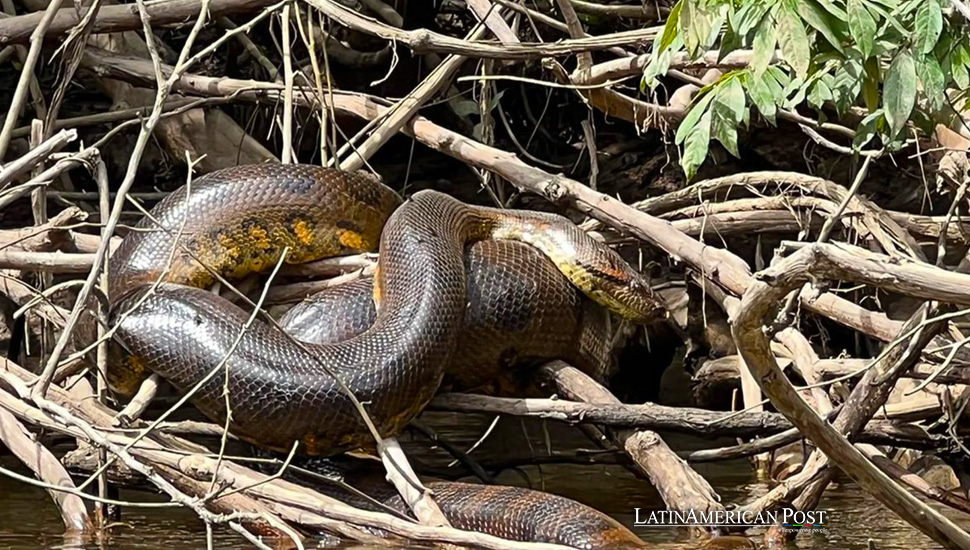Amid the lush, unexplored territories of the Ecuadorian Amazon, scientists have revealed a groundbreaking discovery: a new species of giant anaconda, sparking urgent debates about conservation and the critical threats facing the Amazon’s delicate ecosystems.
Revealing the hidden wonders
In the heart of the Ecuadorian Amazon, a region steeped in biodiversity and indigenous tradition, a remarkable discovery has emerged that sheds new light on the richness and fragility of this vital ecosystem.. Led by Professor Bryan Fry of the University of Queensland, a team of scientists, in collaboration with a National Geographic film crew, has identified a previously undocumented species of giant anaconda, the northern green anaconda (Eunectes Nakajima), in the Bameno region of Baihuaeri. Waorani territory.
This discovery, made while filming National Geographic’s upcoming Disney+ series “Pole to Pole” with Will Smith, is not only a monumental achievement in herpetology; represents a poignant reminder of the incomparable biodiversity of the Amazon and the pressing need to protect it. The identification of the northern green anaconda highlights the critical importance of collaborative research and the role of indigenous knowledge in revealing the mysteries of the natural world.
Bryan Fry
Indigenous wisdom: a key to the secret of the anaconda
The Waorani people, guardians of the Amazon, extended a rare invitation to scientists, guiding them through the dense jungle on a 10-day expedition. Their ancestral wisdom and deep respect for the anaconda, considered sacred within their culture, were instrumental in locating these elusive giants. The enormous female anaconda found measured an impressive 6.3 metres, and local anecdotes suggest the existence of even larger specimens in the region.
This new species is genetically distinguished from its southern counterpart by 5.5 percent, a significant divergence that underlines the Amazon’s role as a cradle of evolutionary diversity. Such a discovery is a milestone in Fry’s career and a testament to the enduring mysteries of the Amazon, which await discovery by those willing to listen and learn from its indigenous inhabitants.
However, this discovery is overshadowed by the imminent threats of deforestation, habitat degradation and pollution, which endanger the newly discovered anaconda and many other species that inhabit the Amazon. The relentless advance of agricultural expansion, mining activities, and fires and droughts induced by climate change paint a dire picture for the future of the Amazon ecosystems.
The Amazon, often nicknamed the “lungs of the Earth,” is at a critical juncture. The discovery of the northern green anaconda is a stark reminder of what is at stake: a biodiversity hotspot that is a repository of untold natural wonders and a key player in the global climate system. As the Amazon advances, so does the health of our planet.
Intercultural collaboration for conservation
The collaboration between scientists and the Waorani people on this discovery exemplifies the potential of cross-cultural partnerships to advance conservation efforts. It is a model that should be replicated throughout Latin America, where the rich network of indigenous knowledge and modern science can come together to protect the continent’s precious natural heritage.
Latin American countries, which share the wealth and plight of the Amazon, must come together to address the ecological challenges facing this region. The destiny of the Amazon is a shared responsibility from Peru to Brazil, from Colombia to Venezuela. Regional cooperation, supported by international allies, is essential in developing sustainable solutions that honor the ecological and cultural integrity of the Amazon.
In light of this discovery, there is an urgent need for comprehensive research into the effects of environmental degradation on Amazon wildlife. The impact of petrochemicals on the reproductive biology of the northern green anaconda and other key species offers a critical area of study that could provide insight into the broader ecological consequences of pollution in the Amazon.
Also read: Ecuadorian cocoa producers advocate for fair trade amid global price rise on Valentine’s Day
As we celebrate the discovery of the northern green anaconda, may it serve as a wake-up call to conservation. Protecting the Amazon and its new inhabitants requires a concerted effort that transcends borders, disciplines and cultures. It is a challenge we must face with the same courage, curiosity and collaboration that led to this remarkable discovery in the first place.
2024-02-27 15:39:23
#species #giant #anaconda #discovered #Ecuadorian #Amazon #among #largest #world #LatinAmerican #Post

